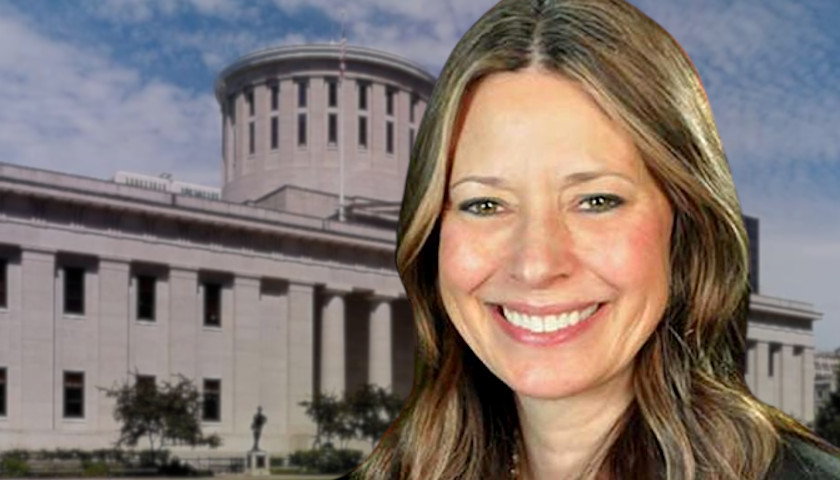COLUMBUS, Ohio – Republican Governor Mike DeWine offered Ohioans a “new deal” late Thursday, saying, “When Ohio gets down to 50 cases per 100,000 people for two weeks, all health orders in the state will come off.”
The announcement came in a specially called press briefing that started at 5:30 p.m., during which DeWine encouraged Ohioans to take the COVID vaccine and to stay the course with nonpharmacological interventions: masks, distancing, state orders that limit crowds and limits on long personal contact.
“Not only now do we have three highly effective vaccines, we also have one battle-tested tool that has proven to work so well – and that is the masks,” said DeWine.
He continued, “[O]ur path back is by continuing forward – by wearing that mask and by getting that vaccine. And while no one will be forced to take the vaccine, the more of us that can get vaccinated and the quicker we can get it done, the more complete will be our victory; the sooner we will have that victory and the more confidently can we put this all behind us.”
The 50 cases per 100,000 residents over two weeks is already measured and frequently reported during COVID briefings. The metric is posted on one of the Ohio COVID webpages, found here.
As of March 3, the statewide average of cases per capita is 179.6, down from 189.8 the previous week. The average would have to drop about 360 percent to achieve the 50-case mark to lift restrictions.
According to DeWine, “On December 3, 2020 Ohio was at 731 cases per 100,000 population over the previous two weeks. On February 3, 2020 – one month ago – Ohio’s cases were down to 445.”
As The Ohio Star reported, DeWine first issued a state of emergency as a temporary measure to help hospitals with the equipment and time they would need to ramp up for the tsunami of cases Amy Acton predicted – a high point of 62,000 a day without mitigation strategies.
At the highest rate of infection in 2020, Ohio never came close to the 62,000 cases a day, the justification for “two weeks to flatten the curve.”
In fact, according to Ohio Department of Health records, the high point in cases occurred on November 30, 2020 when the state logged 13,468 – this after a statewide mask mandate had been in effect for 131 days with the Ohio Investigative Unit measuring mask compliance at well above 90% around the state.
While the mask mandate was in effect with high compliance, Ohio racked up its worst numbers in cases, hospitalizations and deaths according to the Ohio COVID dashboard.
The Star emailed the Ohio Department of Health (ODH) to request more detailed information on how cases will be counted pertaining to the 50 per 100,000 people goal. Specifically, the inquiry sought to determine:
- if confirmed and probable cases were to be included in the tally; and
- whether the number includes positives from antigen tests, PCR tests or both antigen and PCR tests
ODH spokeswoman Alicia Sholtsbrief response:
You can find that information here – https://coronavirus.ohio.gov/static/OPHASM/key-measures.pdf under the Ohio Public Health Advisory System https://coronavirus.ohio.gov/wps/portal/gov/covid-19/dashboards/other-resources/public-health-advisory-system. There are some data definitions which show that it is calculated by symptom onset date over a two-week period, and the footnotes of the PDF list the dates used.
According to the links provided, the calculation will be based on the two-week average of the new cases per capita indicator on the Ohio Public Health Advisory System.
The Star previously reported on how the new cases per capita measure is punitive to smaller counties, includes both confirmed and probable cases, and includes results of antigen and PCR tests – both of which are problematic, in that with high testing levels false-positive results may be enough to push a county, and perhaps the state, above the 50 cases per 100,000 threshold.
Despite being the “gold standard,” PCR tests, according to a Journal of the American Medical Association (JAMA) report, can render positive results for up to 12 weeks, almost 10 weeks past infectiousness – beyond the window of time when the virus can be transmitted.
Antigen tests are also prone to false results, as Dr. Amy Edwards, associate medical director for infection at University Hospitals in Cleveland said. Edwards was commenting on DeWine’s false positive (in August) during an interview with Cleveland19 saying “antigen tests are notoriously plagued with issues of accuracy.” Edwards went on to explain that her health system was rotating rapid antigen tests out of practice.
– – –
Jack Windsor is the Statehouse Reporter at The Ohio Star. Windsor is also an independent investigative reporter. Follow Jack on Twitter. Email tips to [email protected].






“Not only now do we have three highly effective vaccines, we also have one battle-tested tool that has proven to work so well – and that is the masks,” said DeWine.
There is absolutely NO evidence to prove that statement, and he knew it when he said it; that means he’s lying.